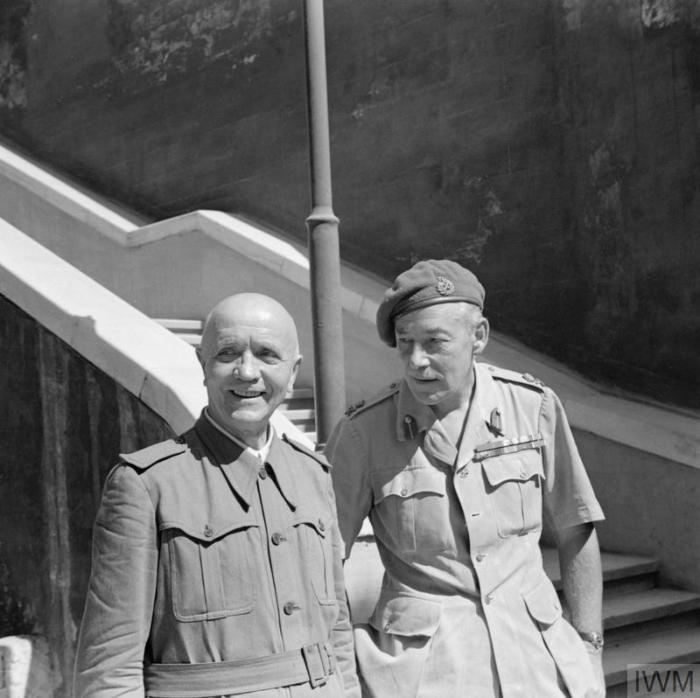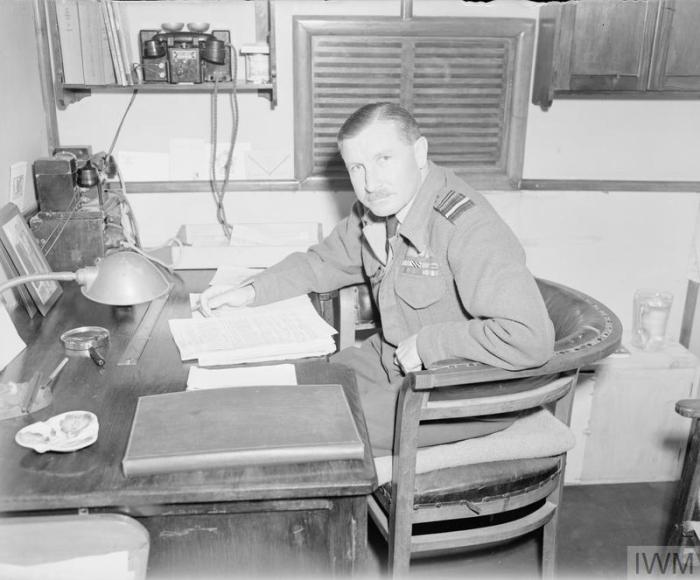By Dr Ross Mahoney
If there is one description of the multi-national and cosmopolitan composition of Allied forces in the Mediterranean theatre during the Second World War, it is ‘complex.’ This comment may seem obvious at first; however, were there not only British and American troops in the theatre but also forces from the Commonwealth and Empire and ‘free’ forces such as those from France and Poland. Also, in the aftermath of the Italian surrender in September 1943, there were also those of the former regime.

By the terms of the instrument of surrender, units of the Italian navy and air force were to be transferred to the control of Allied forces. Once the Italian government under Marshal Badoglio moved to Brindisi, and the long terms of surrender were signed, the Allies set up a Control Commission to enforce the surrender terms. However, even before the Control Commission was established, General Eisenhower had dispatched a Military Mission to Brindisi to transmit military instructions to Badoglio, collect intelligence, and most importantly, coordinate the use of Italian armed forces in the war against German.[1]
It is clear that the use of Italian forces was designed, where possible, to complement Allied combat power in the Mediterranean theatre; however, this came up against some challenges that highlight the problem of integrating former enemies into the Allied force structure. Furthermore, as Marshal of the Royal Air Force Lord Tedder, who at the time was in charge of the Mediterranean Air Command, reflected in his wartime memoirs that, while he was keen to support the use of the Italian air force, that Services needs came secondary to the Allied war effort.[2] Challenges for re-building the Italian air force included administrative, logistical, resource and personnel issue as well as cultural and language difficulties.

The head of the air section of the Military Mission was one Air Commodore Foster, later Air Chief Marshal Sir Robert Foster who later commanded the Desert Air Force and the 2nd Tactical Air Force in Germany in the early 1950s. In Foster’s personal papers, held by the Royal Air Force Museum in London, is a fascinating record of his service with the Military Mission between September 1943 and March 1944.[3] In this recollection, which is what it is as it is clearly entitled the ‘Personal Record of ACM Sir Robert Foster’ and as such probably written after his retirement in the 1950s, Foster details the work he undertook.
The first challenge recalled by Foster was that of morale and linked to that the issue of attitude. Italian forces had by the time of surrender been fighting on multiple fronts and, for a variety of reasons, suffered significant defeats. Added to this, as Foster recollected, was the fact that the Italian’s were being asked to fight with their former enemies against their former allies. Furthermore, motivation was considered to be challenging because of conditions in Italy for the civilian population and the separation of personnel from their families. This was an outcome of the character of the Italian campaign and German failure to withdraw from the peninsula. That Foster identified this as his first requirement was hardly out of character. It was recognised by British forces that the generation of combat power was related to good leadership, command and morale. As such, managing issues such as attitude, culture, identity and loyalties were essential to ensure the provision of an effective force. As Foster wrote:
It was perfectly clear […] that the first step must be to establish a sense of purpose and to find officers with sound qualities of leadership, with good operational experience, and with the basic enthusiasm which would make their Air Force and efficient and useful addition to the allied war effort.[4]
Foster was aided in attempting to implement his first step by recognising the need to gain support from Badoglio’s government and to help with that he appointed Squadron Leader Roger Francis whom both spoke Italian and was a ‘firm Italophile.’
Importantly, it was agreed that Italian units would be grouped to maintain identity, though the Allies would provide stores and logistical support and eventually re-equipment of units. Linked to this were administrative challenges concerning issues such as an operational headquarters to control units that not only served the purpose of Italians but also fitted with existing Allied arrangements. Added to this was the need to communicate to Allied air commanders that the addition of Italian units would be of benefit to the war effort. Foster recollected the ‘excellent service’ of his Italian staff officers fondly, and that ‘at heart, the Italian Air Force air crew were not dissimilar to ours.’[5]

Ultimately, without further research, it is difficult to assess the effectiveness of Foster’s effort to rebuild the Italian air force on the Allied war effort. At a simple level, were the outcomes achieved greater than the effort expended? One thing is sure, while an attempt was made to utilise the Italian air force it was hampered by the fact that the Allies secured only some 300 aircraft and that many continued to be used by forces that remained loyal to the regime in Northern Italy. This led to Italian units being used by the Balkan Air Force and re-equipped with Allied types. Nevertheless, perhaps the critical outcome of this effort was that it laid the foundation for the post-Second World War Italian air force, as such, while the Service might not have been militarily effective in reinforcing Allied combat power, it served a political purpose in the longer term.
This is by no means an exhaustive discussion of the effort to rebuild and utilise Italian forces after the 1943 surrender; however, while it is dangerous to draw historical parallels, the experience of Italian forces after 1943 begs the question of the purpose of rebuilding forces of defeated enemies and the challenges inherent in that process. It is evident from Foster’s recollection that while there were technical and logistical challenges, the key to his ‘success’ was the need to recognise the problem of working with the Italians to ensure that they felt part of the Allied team. A need to maintain some form of identity was paramount to Foster’s work and the subsequent integration of Italian forces who subsequently felt valued as they were able to ‘prove [their] worth under the new circumstances.’[6]
Dr Ross Mahoney is an independent historian and defence specialist based in Australia. Between 2013 and 2017, he was the resident Historian at the Royal Air Force Museum, and he is a graduate of the University of Birmingham (MPhil and PhD) and the University of Wolverhampton (PGCE and BA). His research interests include the history of war in the twentieth and twenty-first centuries, air power and the history of air warfare, and the social and cultural history of armed forces. To date, he has published several chapters and articles, edited two books, and delivered papers on three continents. He is a member of the Royal Historical Society and is an Assistant Director of the Second World War Research Group. He is a member of the Royal Historical Society and an Assistant Director of the Second World War Research Group. He blogs at Thoughts on Military History and can be found on Twitter at @airpowerhistory.
Header Image: A formation of Macchi C.200 of the Regia Aeronautica, c. 1941 (Source: Wikimedia)
[1] On the development of the Allied Control Commission, see: C.R.S. Harris, Allied Military Administration of Italy, 1943-1945 (London: HMSO, 1957), pp.105-28.
[2] Marshal of the Royal Air Force Lord Tedder, With Prejudice (London: Cassell, 1966), p. 469.
[3] Royal Air Force Museum, Personal Papers of Air Chief Marshal Sir Robert Foster, AC75/34/8/23, Personal Record of A.C.M. Sir Robert Foster of Service with the Italian Air Force, September 1943-March 1944, N.D.
[4] Ibid, p. 2.
[5] Ibid, p. 5.
[6] Ibid, p. 6.
This is an interesting subject. One factor, which I find to be of relevance in this particular case, is the atrocities committed by the Germans against the Italians immediately after the Italian capitulation. This bears a two-fold importance. On the one hand, it would have helped bringing the Italians actively to the Allied side against the Germans. But in the same time, this would have helped presenting the only-until-recently aggressors as victims to the eyes of the Allied forces. Especially to those who have suffered by Italian aggression and/or occupation. I am especially referring to the case of Greece but maybe we can make a broader case out of this. The (then) Royal Hellenic Air Force moved to Italy in 1944: 13th Bomber Squadron moved to Italy in April-May ’44 (Catania initially and then to Biferno) while 335 and 336 RAF (Greek) Squadrons followed in September (Nuova initially and then also to Biferno). I would like to read more about the subject from you or from any of your colleagues. Thanks for posting.
LikeLiked by 1 person
Kostas, you may be right about the issue of German reprisals and it deserves further research at some point.
LikeLike
Much belated thanks for the reply.
LikeLike